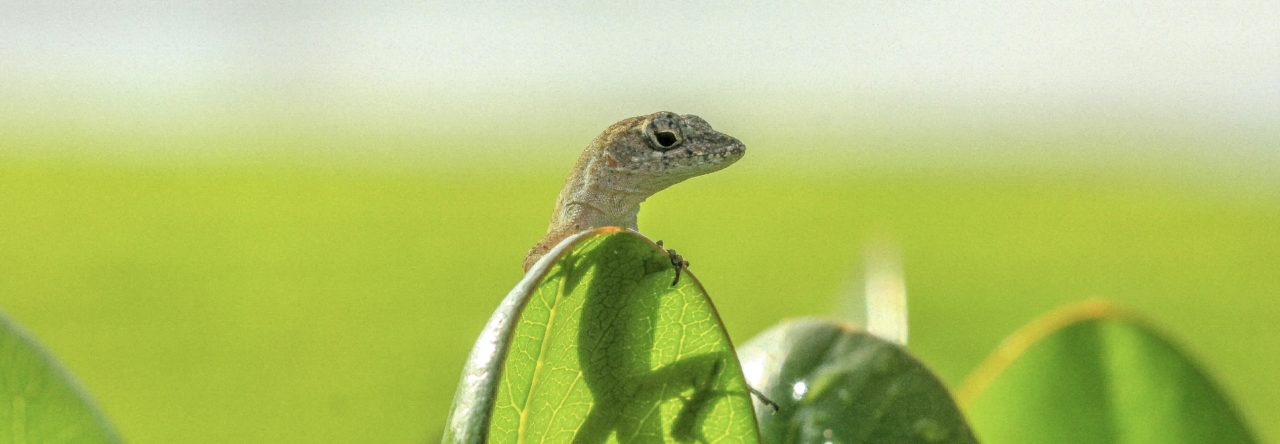
An actively foraging anole on the prowl (A. tigrinus; photo by J. Losos)
Nearly 50 years ago, Eric Pianka proposed the idea that hunting animals forage in one of two ways, either actively foraging for prey or sitting-and-waiting for food to wander by. These ideas were initially promulgated with lizards in mind, and much of the research in the last half century has involved lizards. Anoles haven’t been a major player in the work, but their certainly have been some studies conducted on anoles.
This post is motivated by a paper published by Cooper et al. in Herpetology Notes last year in which new data are presented on six anole species, as well as for a variety of other species. The anole data conform both to previous data on the same species and studies on anoles in general: as lizards go, anoles are on the sit-and-wait end of the spectrum, moving relatively little (think about the other end of the spectrum, species like whiptail lizards which seem to move almost non-stop).
I was surprised in looking through the archives to see that we haven’t previously had a post on AA about foraging mode. Now we do! And for some background: I reviewed what we know about anole foraging in a five-page section of Lizards in an Evolutionary Tree. The take-home messages:
1. By comparison to other lizards, anoles don’t move much and would be considered sit-and-wait foragers;
2. Nonetheless, among anoles, some are much more active foragers than others;
3. Caribbean anoles are much more active than mainland species;
4. Much remains to be learned about the specifics of anole foraging and how it differs among species
And here are some highlights, from the footnotes:
“Some of the danger inherent in an active foraging mode was apparent in another observation of a female [A. valencienni] moving upside down on a bromeliad, searching for prey (quoting from Trivers’ field notes, p. 575): “. . . it seems to spot something on a neighboring bromeliad, also upside down. I too spot something on the second bromeliad. Starts to dart the 5 cm to the neighboring bromeliad but—as if forgetting it is upside down—it steps into thin air and falls 6 m to the ground. It appears to be uninjured.”
“Examples of this prey-catching behavior were provided for the relatively short-limbed A. carolinensis (under the name A. principalis) by Lockwood (1876, p. 7): “I have just been watching Nolie eying a fly which was walking on one of the glass panes of his house. He made a noiseless advance of about three or four inches; then followed a spring, when he was seen cleaving to the glass by his feet, and champing the captured fly. I saw him once intently watching the movements of a fly which was walking on the glass. As seemed evident to me by an ominous twitch of that little head, his mind was made up for a spring; but lo, there was a simultaneous makeup of mind on the part of the fly, which at this juncture flew towards the other side of the case. Then came—and how promptly—mental act number two of Anolis, for he sprang as the after-thought directed, and caught the insect on the fly.” Dial and Roughgarden (1995) report an anole jumping from a branch one meter above a spider web, catching the spider as it passed by, before landing in the vegetation below.”




 Alison Cree, one of the leading researchers on tuatara, has written a comprehensive account of everything we know–and would like to know–about toots. The book not only covers ecology, evolution, behavior, physiology and so on, but also the history of knowledge of tuatara as well as details on how they were perceived by the Maori. And, of course, the incredible conservation turnaround, which has led to reintroduction of tuatara to the New Zealand mainland after a half-millenium absence.
Alison Cree, one of the leading researchers on tuatara, has written a comprehensive account of everything we know–and would like to know–about toots. The book not only covers ecology, evolution, behavior, physiology and so on, but also the history of knowledge of tuatara as well as details on how they were perceived by the Maori. And, of course, the incredible conservation turnaround, which has led to reintroduction of tuatara to the New Zealand mainland after a half-millenium absence.



